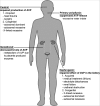Nephrogenic diabetes insipidus: essential insights into the molecular background and potential therapies for treatment
- PMID: 23360744
- PMCID: PMC3610677
- DOI: 10.1210/er.2012-1044
Nephrogenic diabetes insipidus: essential insights into the molecular background and potential therapies for treatment
Abstract
The water channel aquaporin-2 (AQP2), expressed in the kidney collecting ducts, plays a pivotal role in maintaining body water balance. The channel is regulated by the peptide hormone arginine vasopressin (AVP), which exerts its effects through the type 2 vasopressin receptor (AVPR2). Disrupted function or regulation of AQP2 or the AVPR2 results in nephrogenic diabetes insipidus (NDI), a common clinical condition of renal origin characterized by polydipsia and polyuria. Over several years, major research efforts have advanced our understanding of NDI at the genetic, cellular, molecular, and biological levels. NDI is commonly characterized as hereditary (congenital) NDI, arising from genetic mutations in the AVPR2 or AQP2; or acquired NDI, due to for exmple medical treatment or electrolyte disturbances. In this article, we provide a comprehensive overview of the genetic, cell biological, and pathophysiological causes of NDI, with emphasis on the congenital forms and the acquired forms arising from lithium and other drug therapies, acute and chronic renal failure, and disturbed levels of calcium and potassium. Additionally, we provide an overview of the exciting new treatment strategies that have been recently proposed for alleviating the symptoms of some forms of the disease and for bypassing G protein-coupled receptor signaling.
Figures






Similar articles
-
Hereditary Nephrogenic Diabetes Insipidus: Pathophysiology and Possible Treatment. An Update.Int J Mol Sci. 2017 Nov 10;18(11):2385. doi: 10.3390/ijms18112385. Int J Mol Sci. 2017. PMID: 29125546 Free PMC article. Review.
-
Physiopathology and diagnosis of nephrogenic diabetes insipidus.Ann Endocrinol (Paris). 2012 Apr;73(2):128-9. doi: 10.1016/j.ando.2012.03.032. Epub 2012 Apr 13. Ann Endocrinol (Paris). 2012. PMID: 22503803 Review.
-
AQP2: Mutations Associated with Congenital Nephrogenic Diabetes Insipidus and Regulation by Post-Translational Modifications and Protein-Protein Interactions.Cells. 2020 Sep 26;9(10):2172. doi: 10.3390/cells9102172. Cells. 2020. PMID: 32993088 Free PMC article. Review.
-
Genetic forms of nephrogenic diabetes insipidus (NDI): Vasopressin receptor defect (X-linked) and aquaporin defect (autosomal recessive and dominant).Best Pract Res Clin Endocrinol Metab. 2016 Mar;30(2):263-76. doi: 10.1016/j.beem.2016.02.010. Epub 2016 Mar 2. Best Pract Res Clin Endocrinol Metab. 2016. PMID: 27156763 Review.
-
Nephrogenic diabetes insipidus.Adv Chronic Kidney Dis. 2006 Apr;13(2):96-104. doi: 10.1053/j.ackd.2006.01.006. Adv Chronic Kidney Dis. 2006. PMID: 16580609 Review.
Cited by
-
Diabetes Insipidus: Pathogenesis, Diagnosis, and Clinical Management.Cureus. 2021 Feb 23;13(2):e13523. doi: 10.7759/cureus.13523. Cureus. 2021. PMID: 33786230 Free PMC article. Review.
-
Valine-279 Deletion-Mutation on Arginine Vasopressin Receptor 2 Causes Obstruction in G-Protein Binding Site: A Clinical Nephrogenic Diabetes Insipidus Case and Its Sub-Molecular Pathogenic Analysis.Biomedicines. 2021 Mar 15;9(3):301. doi: 10.3390/biomedicines9030301. Biomedicines. 2021. PMID: 33804115 Free PMC article.
-
Folding and Misfolding of Human Membrane Proteins in Health and Disease: From Single Molecules to Cellular Proteostasis.Chem Rev. 2019 May 8;119(9):5537-5606. doi: 10.1021/acs.chemrev.8b00532. Epub 2019 Jan 4. Chem Rev. 2019. PMID: 30608666 Free PMC article.
-
LRBA is essential for urinary concentration and body water homeostasis.Proc Natl Acad Sci U S A. 2022 Jul 26;119(30):e2202125119. doi: 10.1073/pnas.2202125119. Epub 2022 Jul 21. Proc Natl Acad Sci U S A. 2022. PMID: 35862451 Free PMC article.
-
GATA2 regulates body water homeostasis through maintaining aquaporin 2 expression in renal collecting ducts.Mol Cell Biol. 2014 Jun;34(11):1929-41. doi: 10.1128/MCB.01659-13. Epub 2014 Mar 17. Mol Cell Biol. 2014. PMID: 24636993 Free PMC article.
References
-
- Robertson GL. 1987. Physiology of ADH secretion. Kidney Int. Suppl 21:S20–S26 - PubMed
-
- Bourque CW. 2008. Central mechanisms of osmosensation and systemic osmoregulation. Nat Rev Neurosci. 9:519–531 - PubMed
-
- Nielsen S, Frøkiaer J, Marples D, Kwon TH, Agre P, Knepper MA. 2002. Aquaporins in the kidney: from molecules to medicine. Physiol Rev. 82:205–244 - PubMed
-
- Robben JH, Knoers NV, Deen PM. 2006. Cell biological aspects of the vasopressin type-2 receptor and aquaporin 2 water channel in nephrogenic diabetes insipidus. Am J Physiol Renal Physiol. 291:F257–F270 - PubMed
-
- Babey M, Kopp P, Robertson GL. 2011. Familial forms of diabetes insipidus: clinical and molecular characteristics. Nat Rev Endocrinol. 7:701–714 - PubMed
Publication types
MeSH terms
Substances
LinkOut - more resources
Full Text Sources
Other Literature Sources
Medical
Molecular Biology Databases
Miscellaneous

